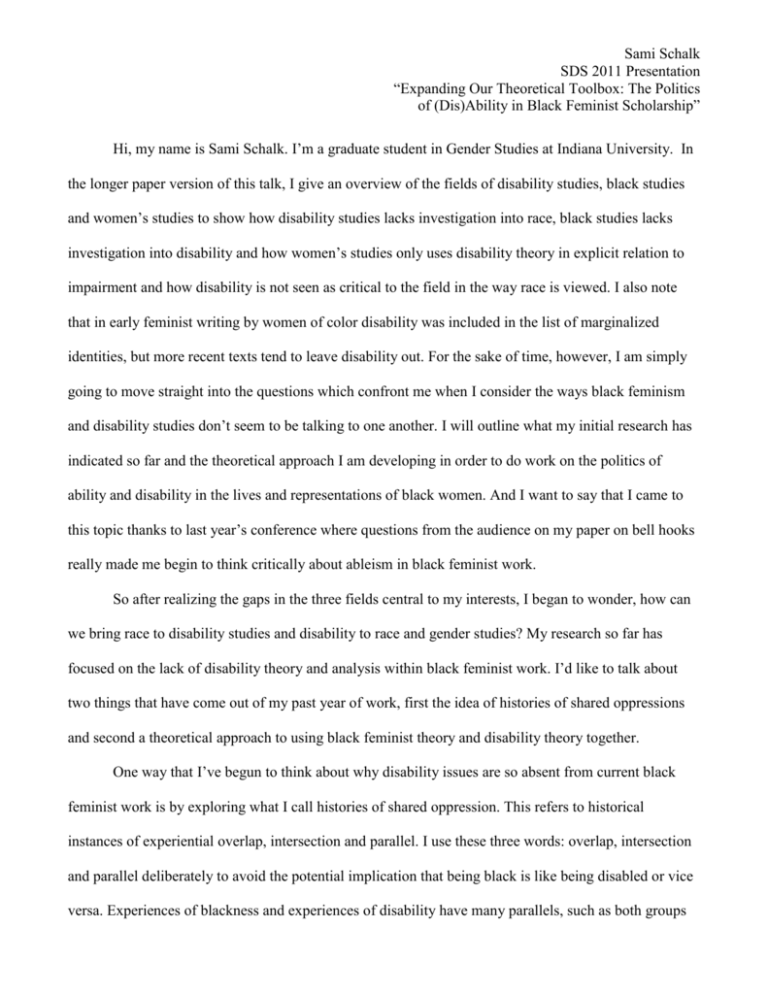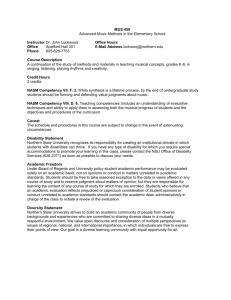Sami Schalk SDS 2011 Presentation “Expanding Our Theoretical
advertisement

Sami Schalk SDS 2011 Presentation “Expanding Our Theoretical Toolbox: The Politics of (Dis)Ability in Black Feminist Scholarship” Hi, my name is Sami Schalk. I’m a graduate student in Gender Studies at Indiana University. In the longer paper version of this talk, I give an overview of the fields of disability studies, black studies and women’s studies to show how disability studies lacks investigation into race, black studies lacks investigation into disability and how women’s studies only uses disability theory in explicit relation to impairment and how disability is not seen as critical to the field in the way race is viewed. I also note that in early feminist writing by women of color disability was included in the list of marginalized identities, but more recent texts tend to leave disability out. For the sake of time, however, I am simply going to move straight into the questions which confront me when I consider the ways black feminism and disability studies don’t seem to be talking to one another. I will outline what my initial research has indicated so far and the theoretical approach I am developing in order to do work on the politics of ability and disability in the lives and representations of black women. And I want to say that I came to this topic thanks to last year’s conference where questions from the audience on my paper on bell hooks really made me begin to think critically about ableism in black feminist work. So after realizing the gaps in the three fields central to my interests, I began to wonder, how can we bring race to disability studies and disability to race and gender studies? My research so far has focused on the lack of disability theory and analysis within black feminist work. I’d like to talk about two things that have come out of my past year of work, first the idea of histories of shared oppressions and second a theoretical approach to using black feminist theory and disability theory together. One way that I’ve begun to think about why disability issues are so absent from current black feminist work is by exploring what I call histories of shared oppression. This refers to historical instances of experiential overlap, intersection and parallel. I use these three words: overlap, intersection and parallel deliberately to avoid the potential implication that being black is like being disabled or vice versa. Experiences of blackness and experiences of disability have many parallels, such as both groups Schalk 2 being, for different reasons, segregated or excluded from schools and other public places, and these experiences also overlap in receiving the same treatments at certain historical junctions or within particular institutions, and these experiences also intersect in the lives of people who are both black and disabled. I believe that by tracing these histories of shared oppression closely, we may be able to understand some of the underlying resistance to issues of disability among black studies scholars and to issues of race among disability scholars. For black women and women with disabilities, there are several historical moments of shared oppression. For example, I’m interested in a moment of parallel experience in the use of involuntary sterilization from the 1950s into the 1980s, when people with disabilities in institutions were being involuntarily sterilized and black women on welfare were often either being sterilized without their knowledge or forced to choose between sterilization (sometimes in the form of the DepoProvera birth control shot) and continuing to receive benefits. I also believe our current period is also one of shared oppression, a moment of intersection with the rising rate of HIV/AIDS infection among black women and thus a rising rate of black women becoming disabled from virus-rated complications. Other histories of shared oppression might include the over-representation of children of color with learning disorder diagnoses or the lack of incentive or support to build job skills and/or work while receiving governmental support. While these are just a few examples, I think it’s clear that there is important work that still needs to be done, work that can benefit from using both black feminist theory and disability theory. The way I propose to do this work is to use a theoretical approach which contains a deep understanding of and dedication to intersectionality in the true sense of the word. As Patricia Hill Collins writes, intersectionality takes a “holistic approach [and] treats the interaction among multiple systems as the object of study” (Collins 20). This is different from an “add and stir” diversity approach that simply includes various identity issues without actually integrating them, using them as variables within one overarching or most important system of oppression. Therefore, I am interested in an Schalk 3 intersectional theoretical approach which seriously considers the complex ways through which multiple identity markers, such as race, class, gender, sexuality and disability/ability, work to create marginalization and/or privilege in the material, intellectual and emotional lives of individuals or communities. It is important to note here that when I use terms likerace and gender, I do not mean them to be a metonym for the marginalized identities within the term. Jacqueline Nassy Brown discusses this briefly in her book, Dropping Anchor, Setting Sail, in which, at one point, she encourages scholars of the diaspora to study gender in its full range of meanings, not simply using gender to mean women, women’s experiences or femininity (Brown 56). Similarly, race does not just mean people of color, class does not only reference the working class and sexuality is not only pertinent for studies of queer or nonheterosexual people. An issue arises in the use of the word disability which, by definition, does refer directly and exclusively to actual impairment or the social construction and perception of impairment. This is why I use textual forms which clearly reference both disability and ability, either dis/ability or (dis)ability when I am using the term in the sense of gender while I use the word disability plainly when I am referencing impairment. I believe a successful intersectional approach not only looks at marginal identities, but also explores the majority or privileged identity aspects of an individual or community in order to better understand how marginalization and oppression is altered, mitigated or lessened by privilege. This move to interrogate the privileged sides of identity binaries can be clearly seen in the development of whiteness studies and masculinity studies as well as Fiona Campbell’s book Contours of Ableism which has been critical to my own thinking and I believe is a key theoretical development for beginning work which incorporates black feminist theory and disability theory. Campbell’s book is the first the promote studies in ableism. In Contours, Campbell argues for critical disability scholars to shift the focus of contemporary disability studies scholarship to the “epistemologies and ontologies of ableism” (3). She further writes that current scholarship focuses on disability and disableism, defined as “a set of assumptions (conscious or unconscious) and practices that promote the differential or unequal treatment of people because of actual or presumed disabilities” (ibid Schalk 4 4). Campbell believes, however, that the new challenge is to invert this traditional approach and begin to focus on “the production, operation and maintenance of ableism” (ibid). She defines ableism as: “A network of beliefs, processes and practices that produces a particular kind of self and body (the corporeal standard) that is projected as the perfect, species-typical and therefore essential and fully human. Disability then is cast as a diminished state of being human” (Campbell cited in Campbell 5). The distinction between ableism and disableism is important. I think of this in terms of analogy. Racism is discrimination against people of color while white supremacy is the overvaluing whiteness. Sexism is discrimination again women and femininity while patriarchy is the systematic privileging of men and masculinity. So, going back to those lovely days of standardized testing, we could think that disableism is to ableism as racism is to white supremacy and sexism is to patriarchy. Most importantly for the work I’m proposing, Campbell writes in her conclusion: The reality is that studies in ableism offers more than a contribution to re-thinking disability. These studies provide a platform for reconsidering the way we think about all bodies and mentalities within the parameters of nature/culture. In that sense, studies in ableism has the capacity to reconfigure both race and gender studies. (198, emphasis in the original) One issue that comes up for the work I am interested in however, is that Campbell’s studies in ableism assumes that enough groundwork has been done on impairment and disability, on disableism as it were, and that it is now time for critical disability studies scholars to conduct studies in ableism. She insists that “studies in ableism must not spell a separation with disability studies” but must reconfigure and extend it (Campbell 198; emphasis in the original). Here, Campbell makes the assumption that there is something, or enough of something, from which to extend. But studies in disability and race have not been extensively undertaken and so to move directly to studies in ableism and race would be to take as the base white disability studies and its theories and approaches which may or may not be the most useful for investigating the role of ability and disability in relation to people of color. We cannot know Schalk 5 whether or not current (white) disability studies scholarship provides an adequate basis from which to study ableism/ability and race until we have also more extensively studied disableism/disability and race. I would argue that to not have a solid grounding in—and continual push for more—disability scholarship on people of color is just as dangerous of a move for studies in ableism scholars as a complete separation from disability studies. Therefore, I want to draw attention to the need to continue to build scholarship on race and disability while also beginning to interrogate the intersections of and relationships between ableism and white supremacy. This then is the theoretical approach that I am attempting to develop and use in my work, an approach that, at this point, I can only call Black Feminist Disability Studies, not as an actual new, separate field, but as a renewed intersectional approach that takes these issues and their interactions seriously. This type of work would not only focus on black disabled women, though clearly that group would be critical, but also non-disabled black people and the role ableism in their lives. A Black Feminist Disability Studies approach then takes all sides/aspects of the race, gender, and disability/ability spectrums into consideration and attempts to understand how the overarching systems have historical and material affects on people’s lives within specific contexts. This is what I am attempting to do in the beginning stages of my doctoral research and I am eager to hear your thoughts and suggestions. Thank you. Works Cited Bell, Chris. “White Disability Studies: A Modest Proposal”. The Disability Studies Reader. Routledge: 2006. Print. Brown, Jacqueline Nassy. Dropping Anchor, Setting Sail: Geographies of Race in Black Liverpool. Princeton, NJ: Princeton University Press, 2005. Print. Campbell, Fiona. Contours of Ableism: The Production of Disability and Abledness. New York, NY: Palgrave Macmillan, 2009. Collins, Patricia Hill. "Learning from the Outsider Within: The Sociological Significance of Black Feminist Thought." Social Problems 33.6 (1986): 14-32. Print. Davis, Lennard J. “Preface to the Second Edition”. The Disability Studies Reader. ed. Lennard Davis. New York, NY: Routledge, 2006. xiii-xiv. Print. Rowden, Terry. The Songs of Blind Folk: African American Musicians and the Cultures of Blindness. Ann Arbor, MI: University of Michigan Press. 2009. Print.








